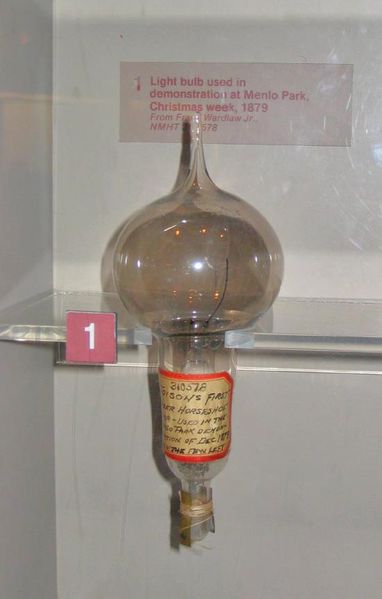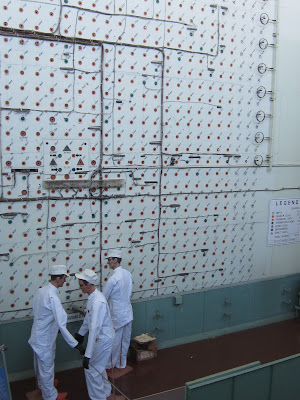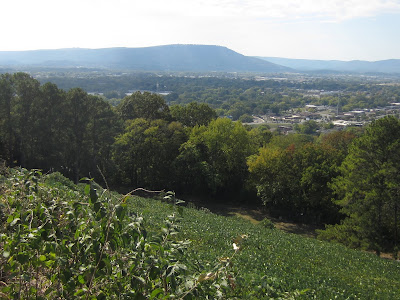Imagine life without recorded music, movies, instantaneous
communication. Even more basically, imagine life without electricity. The
origins of our digital era with its amenities began during a great age of
invention in the last quarter of the 19th century, epitomized by
Thomas Alva Edison. He and his team created products that continue to impact
the lives of billions of people worldwide. In this posting, we will visit his red
brick laboratory complex at West Orange, New Jersey. It is an incredible window
into Edison and his empire of inventions, some of which started in this laboratory.
From lighting the night to providing recorded music and theater for consumption
by a mass audience, Edison revolutionized our world.
 |
| In the Chemistry lab building at Edison NHP (Photo by Hunner) |
Born in 1847, Edison was the youngest of seven children and did
not speak until he turned four. As a teenager, he worked on the Grand Trunk
Railroad selling candies and newspapers, and perhaps his deafness began then,
when a station master boxed his ears in punishment for a fire he started during
a chemical experiment in a baggage car. Later, Edison commented: “Even though I
am nearly deaf, I seem to be gifted with a kind of inner hearing which enables
me to detect sounds and noises that the listeners do not perceive.”
While a teenager, he learned to decode telegraph messages.
In the 1860s, telegraphs connected the country as messages sped across
distances that previously took weeks and even months to travel. Telegraphy,
like digital technology today, transformed the country. Here’s another
similarity: the dots and dashes in Morse Code share the binary cypher of the
digital’s 0s and 1s.
 |
| Telegraph key with Leyden jar batteries (Photo by Hunner) |
In 1863, Edison became an itinerant telegraph operator, filling
in for the operators who left to serve in the Signal Corps during the Civil War.
He wrote down news reports, sent business orders, and coordinated the safe
passage of the trains. While there, Edison invented a machine which recorded rapidly
incoming messages and then replayed them more slowly. As the energy that
transported the telegrams, electricity attracted Edison’s inventive mind.
Electricity has been around a long time. The Greeks noticed
a weird attractive charge when they rubbed amber. William Gilbert, a 17th
century English physician named static electricity “elektron,” the Greek name
for amber. Electrical innovators started storing this electricity in glass
containers filled with water. In 1746, Pieter van Musschenbrock of the
University of Leyden touched such a jar and was jolted to the floor. These early
batteries were subsequently called Leyden jars. In 1831, the Englishman Michael
Faraday rotated wire between magnetic poles and produced an electrical charge.
Using this knowledge, he created “dynamos,” which generated powerful electrical
currents.
Back in the telegraph office at Western Union, Edison discovered
how to send messages over a single line in both directions, boosting the
traffic that existing lines could carry. At the time, the major users of telegraphs included
railroad companies, news organizations, and stock market firms. Stock prices
came out as dots and dashes on a paper ticker tape which Edison then transformed
into spoken words. From this, he recorded “Mary had a little lamb” onto a tin
foil cylinder, and the recording industry began.
Edison claimed to make a small invention every ten days and
a big one every six months. All told, he held a world record 1,093 patents which
included among ones for phonographs, incandescent light bulbs, generation and distribution
systems to light homes and businesses, nickel-iron-alkaline storage batteries, multiplex
transmitting telegraph systems, early motion picture viewers, electrographic
vote recorders, and cement. He was also working on making synthetic rubber.
Here’s his greatest invention— bringing light to night. True,
gas lights illuminated buildings and streets, but they caused fires. Edison’s challenge
was two-fold. First, make a low wattage incandescent light bulb. Second, build
a network that safely transmitted hazardous electrical currents across city blocks
and into buildings. In 1878, he carbonized a thin thread of cotton, attached it
to platinum posts and then vacuum sealed it in a glass bulb. Passing a current through
it lit the bulb which burned for hours with very little use of electricity.
Edison prepared to show the public his latest invention.

On New Year’s Eve in 1879, people thronged to Edison’s lab
at Menlo Park, New Jersey to witness the forty lamps that lit up its buildings
and grounds. Biographer Mark Essig described the scene: “those assembled were
among the first people in the world to see the marvelous glow of incandescent
light. No flame, no flicker, no soot, no fumes—just pure steady light.”[1]
With a workable light bulb, Edison then announced that he would build a
commercial station in New York. He set out to “subdivide the light” for homes
and businesses.
To safely electrify the tip of Manhattan, Edison had to
build a reliable generator and a distribution system of wires, conductors, and
insulators. Using his campus at Menlo Park, the electrical team tested
different generators. They also coated copper wire with various types of insulation,
strung the wire on poles, and sent electricity through the system. After months
of trial and error, Edison successfully activated the Menlo Park system on
November 2, 1880. Now he was ready to electrify New York City.
With the confidence and the drive needed to make electricity
a commercial success, Edison chose a fifty-one square block segment of lower Manhattan,
centered around Wall Street. He installed a dynamo at the station on Pearl
Street and then proceeded to bury his conducting lines underground, resulting
in frequent delays and mounting costs. Nonetheless, on September 4th,
1882, the generators at the Pearl Street station spun up, and lights flickered
on at the office of one of Edison’s main financial backers, Drexel, Morgan and
Company. Only fifty-nine customers that day could switch on their lights, but incandescent
lighting spread quickly through New York City.
Edison moved
the invention factory from Menlo Park to West Orange in 1887. The lighting
business’s success helped finance the expansion. This complex (which is the Edison
National Historical Park) holds buildings for experiments in chemistry,
metallurgy, a powerhouse, a main laboratory, and the Black Maria, Edison’s
movie studio. The main three story lab building
has a library, heavy and precision machine shops, a supply room, and a
recording studio.
 |
| Edison's headquarters at West Orange. The five story building behind where his inventions were commercially manufactured. (Photo by Hunner) |
 |
| Edison's library at West Orange (Photo by Hunner) |
Today,
visitors can see many of the machines and materials that Edison and his team
used.
You can
look into the storeroom which held everything from human hair and exotic plants
to metal tools and platinum. As Edison noted, the supply room held “everything
from elephant hide to a Senator’s eyeball.” The rest of the first floor is
overwhelmed with all types of heavy machinery and tools. The generator at one
end of the large room ran large overhead belts that powered the lathes, drills,
saws, and grinders to build anything from a lady’s watch to a locomotive.
 |
| The historic photo on left shows how the heavy equipment workshop has not changed. (Photo by Hunner) |
The top floor
was devoted to sound. A Steinway piano sits in one room surrounded by
phonographs and wax cylinders that recorded music while another has a wide
range of megaphones to broadcast sound. The largest megaphone in this room
stands eight feet nigh.
 |
| A megaphone and the cylinders for recorded sound projection sound (Photo by Hunner) |
As I walked
past the cabinets that held light bulbs, a variety of phonographs, movie
projectors, a miner’s safety cap with light, and numerous other products of
Edison’s imagination, I realized that these were the first jukeboxes, the first
electric violins and guitars, the first movie projectors, and the first I-Pods.
Most of the electrical devices so essential to our lives today have some DNA from
Thomas Edison.
 |
| Amplified violins (Photo by Hunner) |
Tucked
into a corner of the Edison Park is Black Maria, the first movie studio in the
world. This weirdly shaped building showcases Edison’s pioneering efforts in
creating motion pictures. In 1888, Edison and his team created the Kinetoscope
which used a revolving shutter to expose still images of a moving object onto
celluloid film.
 |
| Edison's movie studio, the Black Maria (Photo by Hunner) |
By 1894, the
West Orange team turned to the commercial application of moving pictures. They
built a wooden cabinet that allowed individuals to view things like horses
galloping or trains. Edison balked at making a movie projector, thinking that
the market was in these penny arcade shows.[2]
 |
| A kinetoscope-- notice the viewer at top for one person (from wikimedia) |
In
addition to what he invented, Edison also changed the way inventors worked. As
biographer Paul Israel notes: “As he invented a system of electric lighting,
Edison was simultaneously reinventing the system of invention.”[3]
While he turned his good ideas into ground breaking inventions, he also created
the corporate invention factory that protected those new ideas and turned them
into profitable consumer products.
He also
looked to the future and foresaw the need for alternative energy: “We are like
tenant farmers chopping down the fence around our house for fuel when we should
be using Nature’s inexhaustible sources of energy--sun, wind and tide! …. I hope we don’t have to wait until oil and
coal run out before we tackle that.” From practical products to visions for
tomorrow, Edison revolutionized the world we live in. He helped create our
electronic and now digital world, and his diverse inventions continue to define
and inform our era.
Edison died in 1931, but this lab continued until 1935. Then
it closed, and everything in it mothballed. The family eventually turned the
campus over to the NPS in the early 1960s. Upon inventorying the site, the NPS
found over 400,000 objects on the grounds, from a rhinoceros horn in the stock
room to the massive machinery in the main building to phonographs and movie
projectors. Many historic sites have buildings and artifacts that are replicas
of the original. Not here. These are the actual buildings, labs, and equipment
that Edison and his team of inventors and engineers worked with as they changed
our world.
 |
| Edison's elevator from the heavy equipment shop floor (Photo by Hunner) |
In 1963, Congress established the Edison National Historic
Site which included the lab complex and Edison’s nearby private resident,
Glenmount. In 2009, Congress redesignated the site as the Thomas Edison
National Historic Park.
Next week, we return to the Civil War and visit some of the
early battlefield parks.









































